Roasted Butternut Squash
This Roasted Butternut Squash is truly delicious enough to be eaten on its own as a simple side dish, or used as an ingredient for salads or recipes like Butternut Squash Soup. This is one of those great recipes that once you try it, you’ll find yourself making big batches for meal prep, freezing, and dinners.
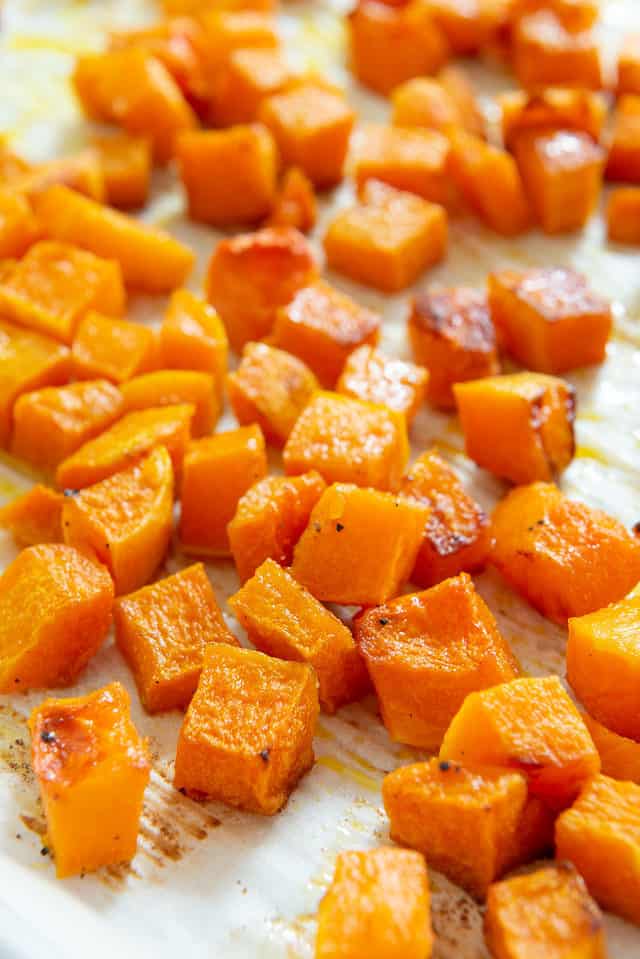
Though I’ve prepared butternut squash in many different ways, this is my preferred way to make it. If you’ve never had it simply roasted in cubes before, prepare to be amazed by how delicious it can be.
With only 4 ingredients, it doesn’t seem like it could possibly be that good, but when you combine the hot dry heat of a good roast in the oven with lots of surface area, you get a ton of delicious caramelization. This is easily my family’s favorite fall side dish!
Cutting into cubes = more caramelization
Even though it’s more work to cut cubes instead of roasting the squash whole, doing it this way gets you a TON more caramelization, depth of flavor, and sweetness.
Don’t want to cut it yourself? Many grocery stores like Costco and Whole Foods sell it pre-cut in fresh form, and that takes away most of the work if you’d rather not mess with it. Unfortunately, I don’t recommend the frozen stuff. The texture is pretty bad.
Why This Recipe Method Is the Best
Most delicious end results – Roasting the squash in cubes is the best because you caramelize the most surface area and get the deepest flavor. These little bites are so good!
Caramelized but not burned – I share some tips below for how I get golden brown and caramelized edges but without burning or scorching.
So many ways to use it – I’ll often roast big trays of this, then save some of the squash for making soup or other recipes. There’s so much you can add this to like salads or even using as a swap for pumpkin puree in recipes like Pumpkin Muffins. I share more ideas at the end of the post.
Easily customizable – While you’re tossing the cubes of butternut squash with the oil, kosher salt, and black pepper, feel free to toss in whatever spices you’d like, such as ground cinnamon, cloves, ginger, or cardamom. This really enhances the fall flavor.
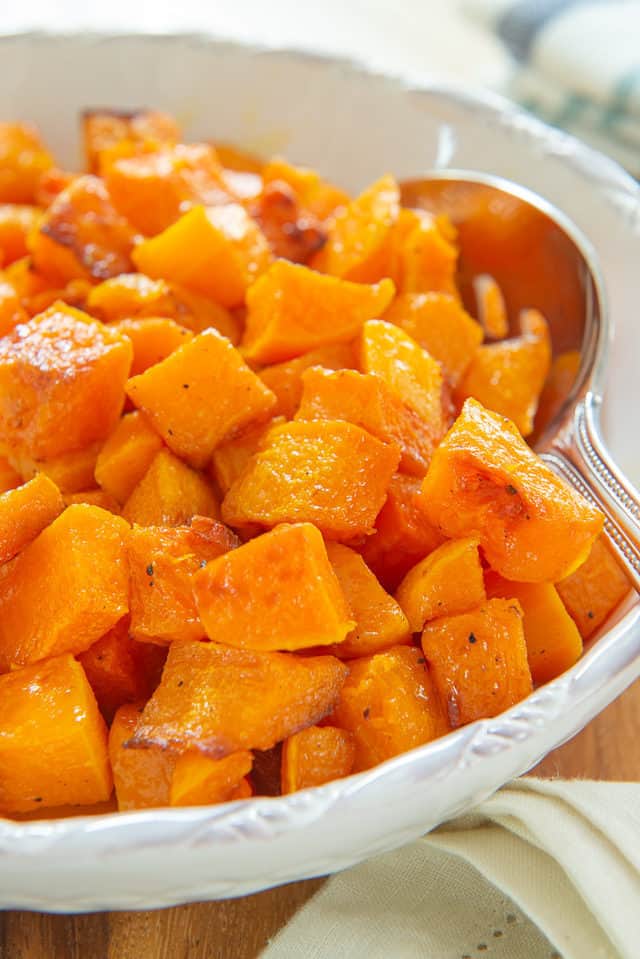
Tips for Best Results
Pick a good butternut squash – Look for a squash that has a dark beige color and a very firm texture. If it’s starting to feel soft or if it has a lot of dings, cuts, or bruises, pick a different one. You also want the stem to be firmly intact instead of fallen off, and ideally you want the heaviest squash for its size, which indicates more moisture inside.
Use parchment paper – Sometimes you want direct contact between the food you’re cooking and the pan, but for this kind of squash, you don’t. What tends to happen in my experience is that the squash is too delicate, and tends to stick to the sheet pan, even with oiling.
Stop to toss partway during cooking – I’ve used a lot of ovens, even really expensive ones, and they all seem to have hot spots. For the most even cooking, toss the cubes around to redistribute everything.
Step by Step Overview:
Unless you’re buying it pre-cut from the store, you’ll first need to select, peel and cut the squash into cubes on a sturdy cutting board. Here’s a quick visual guide for How to Cut Butternut Squash into even pieces if you don’t know how to do it.
I find that 1-inch cubes are best. The key is to separate the bulb at the bottom from the upper portion, and use both a sharp vegetable peeler and a sharp chef’s knife for cutting, especially when trimming the ends of the squash.
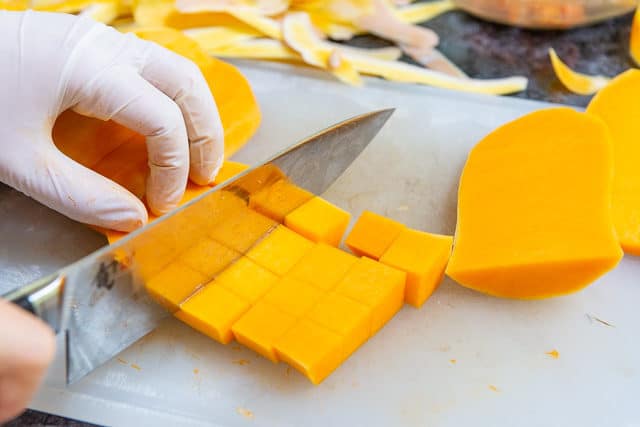
If you’d like, you can cut the butternut squash cubes up to 3 days ahead, and keep them in the fridge for roasting later. This is the easiest way for me to make this fresh when it’s convenient, without having to commit to prep time right before making this in the evenings.
Toss the cubes in a bowl, not on the tray
Get a big bowl for tossing everything together, which will aid you in coating every piece evenly in oil for maximum browning. Trust me, this is the best way and one of my secrets to the greatest roasted vegetables like Roasted Cauliflower and Roasted Sweet Potatoes. Tossing it on the sheet pan just doesn’t coat everything as evenly.
Combine the cut cubes with the oil of your choice, salt, and black pepper. I don’t usually add spices, but if you want to add any other seasonings like chili powder, cayenne pepper, garlic powder, or fresh herbs, now is the time to do it.
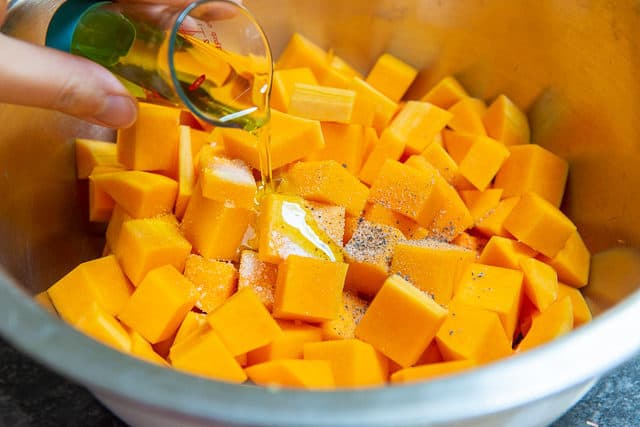
I now prefer animal fats like duck fat, tallow, lard, and ghee for their wonderful flavor, but you may use olive oil, avocado oil, coconut oil, or any other high heat roasting fat you prefer.
Toss everything well to coat the cubes evenly in the oil and seasonings.
Give the pieces space to breathe
Spread the pieces evenly on a parchment paper lined baking sheet in a single layer, making sure they have a little space between them. That way they don’t steam each other, and have a chance to brown.

The parchment paper is essential here and prevents burning. Getting the perfect golden edges is all about finding that side of the line where the squash is caramelized and golden, but not burned, and the parchment helps with that.
Toss partway through cooking to maximize browning
Partway through baking, toss the pieces well to redistribute everything, and keep roasting in the hot oven until caramelized and soft. I have found in my recipe testing that tossing to redistribute is truly one of the secrets to perfectly caramelized vegetables that aren’t burned. Ovens tend to have hot spots, so this allows for more even cooking overall.
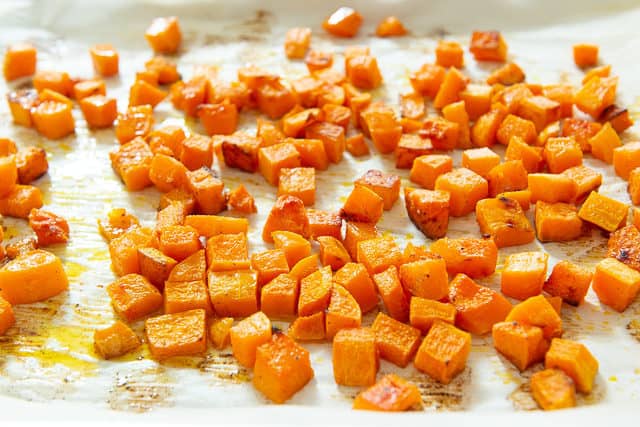
Exact total timing will depend on the size of your cut pieces and your oven, so it’s important to keep your eye on it. They are perfect when caramelized on the edges and fork tender, but not dried out. This is usually around 40 minutes.
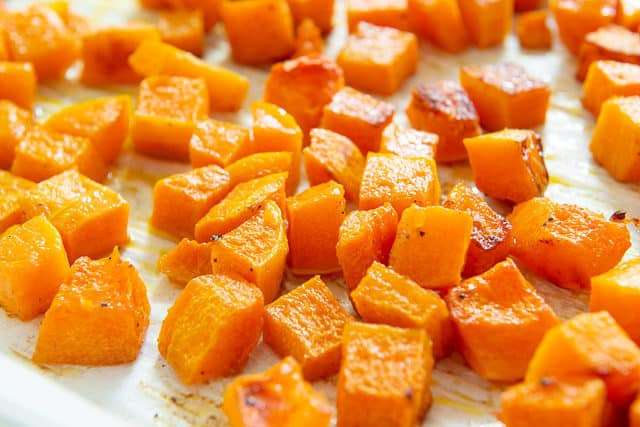
How to Serve It
Once the roasted butternut squash cubes are caramelized and fork tender, they are ready to enjoy! Most of the time, I simply serve this in a bowl as is with a large spoon, because we love it that much, whether for weeknights or for the holiday table. It’s one of our family’s favorite healthy recipes. But here are a few more ideas for enjoying this recipe.
- Add to salads like a Cobb Salad or Kale Salad.
- Blend into a pasta sauce like I do in these Cheesy Stuffed Shells.
- Add as a pizza topping like for this Squash Pizza.
- Add to a bowl of Ground Turkey Chili.
- Add as a focaccia topping as I do in this Caramelized Onion Focaccia.
- Add to bowls of quick Chicken Noodle Soup.
This cooking method also works well with comparable types of squash, but especially Honeynut squash, which people sometimes refer to as mini butternut squash. Delicata, Kabocha, Buttercup, and sugar pie pumpkin also cook nicely this way.
Recipe FAQ and Tips
Store in an airtight container in the fridge for up to 5 days.
Absolutely, but know that the texture won’t be quite the same as fresh, so I prefer to freeze it for blended or pureed recipes like soups or sauces.
Yes, you can do the prepwork of peeling and cutting the vegetable into cubes up to 1 day before. Store in the refrigerator. Or, you can make the whole recipe and then later reheat the cubes in the microwave or oven.
The least soggy method is to spread the cubes on a parchment paper lined baking tray and bake in a 300F oven for 10 minutes. You may also microwave them until warmed through.
Did you enjoy the recipe? Please leave a 5-star rating in the recipe card below and/or a review in the comments section further down the page. Or, follow me on Facebook, Instagram or Pinterest!
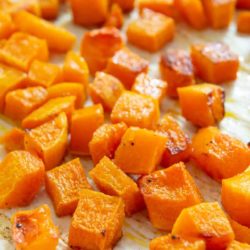
Roasted Butternut Squash
Ingredients
- 3 lb butternut squash*
- 3 tbsp olive oil**
- 1/2 tsp salt
- 1/4 tsp black pepper
Instructions
- Preheat the oven to 400 F. Line a baking sheet with parchment paper.
- Peel and cut the squash into 1" cubes (see my visual guide on How to Cut Butternut Squash, if needed).
- Place the cubes into a large bowl, and toss well with the oil, salt, and black pepper.
- Spread the pieces out evenly onto the parchment lined baking sheet, scraping any oil from the bowl onto the paper as well.
- Roast for 30 minutes, until the cubes are starting to brown on the edges.
- Use a turner to flip and redistribute the squash throughout the pan, and roast for another 10-20 minutes, until the pieces are soft and thoroughly caramelized on the outer surfaces, but not burned. It's important to keep your eye on it.
- Let cool slightly for a couple minutes, then serve!
Notes
Nutrition
Nutrition is estimated using a food database and is only intended to be used as a guideline for informational purposes.

21 Comments on “Roasted Butternut Squash”
Delicious and perfect! I Followed the directions exactly and these are now going to be one of my favorite side dishes! Thanks for sharing your recipe!
Can you do this in an air fryer? If so how long and what temperature?
I make this often, but season it with cumin and add small pieces of onion. Try it, you will like it!
Delicious! Caramelized on the outside, soft and perfect on the inside. Used cubed butternut squash found in the produce section. Delicious as side dish and amazing in the soup.
This was a delicious recipe- I just added a little sprinkle of brown sugar all over the squash once it was spread out in the pan. Delicious and carmelized.
I’m roasting the squash to deliver to someone. How do they safely reheat?
Love your recipe! I did add some cinnamon & boy it came out delicious
First timer and so glad I used your instructions and recipe! Wonderful! No longer intimidated by this squash! Will definitely be doing this again and again! Thanks so much!
Will the squash still roast and caramelize if i use canola oil instead of olive oil?
Yes, doesn’t matter what oil you use. Enjoy!
Love the roasted butternut squash soup recipe! Mmmm mmm mm!!
Perfect!
Thanks a lot for sharing this gem.
Delicious. Deceptively easy. Cook as described for best results.
I have a question. Can you do all of this with frozen butternut squash?
I tried frozen butternut squash once and it was awful. I didn’t try roasting it, but honestly I think it’s probably not a good idea. Freezing changes the texture of squash drastically.
very good recipe
This was so easy to make and after putting it in the blender and adding the heavy whipping cream to it, it tastes amazing! Thank you so much for the recipe!
It’s crazy how much better it tastes when roasted in little cubes. Caramelized goodness! My kids devour trays of these.